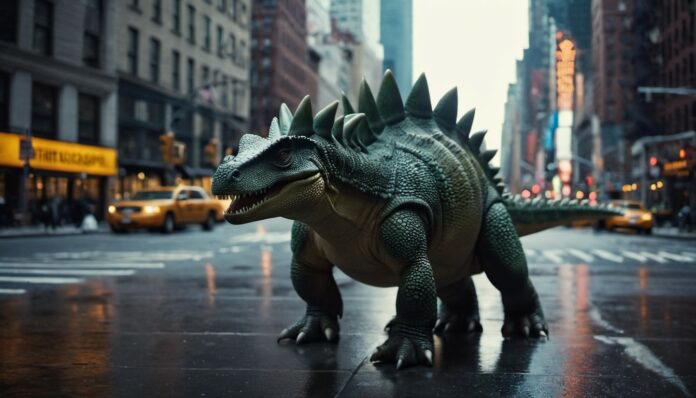Dinosaurs were a diverse group of reptiles that dominated the Earth for over 160 million years during the Mesozoic Era, from approximately 230 million years ago until their extinction around 65 million years ago. They were some of the largest and most impressive creatures to ever roam the planet.
Why are They Called Dinosaurs?
The term “dinosaur” comes from the Greek words “deinos” meaning “terrible” or “fearfully great,” and “sauros” meaning “lizard” or “reptile.” This name reflects their awe-inspiring size and appearance.
Biggest Dinosaur: Argentinosaurus
Argentinosaurus is one of the largest dinosaurs ever discovered. Here are some key facts about it:
- Size: Argentinosaurus was estimated to reach lengths of up to 100 feet (30 meters) from head to tail.
- Weight: It could weigh as much as 70-100 tons, making it one of the heaviest land animals known.
- Classification: It belonged to the sauropod group, known for their long necks, long tails, and four-legged stance.
- Diet: Like other sauropods, Argentinosaurus was herbivorous, feeding on plants to sustain its massive body.
Smallest Dinosaur: Microraptor
Microraptor is one of the smallest non-avian dinosaurs discovered so far. Here are some details about this tiny dinosaur:
- Size: Microraptor was about the size of a crow, measuring roughly 2 feet (0.6 meters) in length.
- Weight: It weighed around 2-4 pounds (1-2 kilograms), similar to a modern-day bird.
- Appearance: Microraptor had feathered wings on both its forelimbs and hind limbs, resembling a small gliding dinosaur.
- Habitat: It lived during the Early Cretaceous period in what is now China.
- Diet: Microraptor was likely carnivorous, feeding on small vertebrates and possibly insects.
Interesting Facts About Dinosaurs
- Lived Long Ago: Dinosaurs lived between 230 and 65 million years ago during the Mesozoic Era.
- Three Periods: The Mesozoic Era is divided into three periods: Triassic, Jurassic, and Cretaceous.
- First Discovery: The first dinosaur fossil was discovered in the early 19th century.
- Diverse Species: There were over 700 different species of dinosaurs.
- Huge Size Range: Some dinosaurs were as small as chickens, while others were over 100 feet long.
- Fossil Evidence: Dinosaurs are known mainly from their fossilized bones.
- Feathers: Some dinosaurs, like Velociraptor, had feathers.
- Bird Ancestors: Birds are considered modern-day descendants of small, feathered dinosaurs.
- T. Rex: Tyrannosaurus rex is one of the most famous and feared dinosaurs.
- Long-Necked Giants: Sauropods, like Brachiosaurus, had long necks and were the largest land animals ever.
- Horns and Armor: Dinosaurs like Triceratops had horns, while others like Ankylosaurus had armor.
- Herbivores: Many dinosaurs were plant-eaters, like Stegosaurus.
- Fast Runners: Some dinosaurs, like Ornithomimus, could run very fast.
- Social Animals: Many dinosaurs lived and traveled in herds.
- Nest Builders: Some dinosaurs, like Maiasaura, built nests and cared for their young.
- Extinction: Dinosaurs went extinct about 65 million years ago, likely due to a massive asteroid impact.
- Megalodon Misconception: Megalodon was not a dinosaur; it was a giant prehistoric shark.
- Egg Layers: Dinosaurs laid eggs, and some nests contained dozens of them.
- Cold-Blooded Debate: Scientists debate whether dinosaurs were cold-blooded like reptiles or warm-blooded like birds.
- Fossilized Tracks: Dinosaur footprints have been found and give clues about their behavior.
- Skin Impressions: Some fossils show impressions of dinosaur skin.
- Coloration: We don’t know for sure what color dinosaurs were, but some likely had bright colors or patterns.
- Brains: Some dinosaurs had very small brains compared to their body size.
- Gigantic Hearts: Large dinosaurs had big hearts to pump blood to their bodies.
- Dinosaur Naming: The word “dinosaur” means “terrible lizard.”
- Continental Drift: Dinosaurs lived on a single large landmass called Pangaea before it split into continents.
- Ceratopsians: This group included horned dinosaurs like Triceratops.
- Theropods: This group included meat-eating dinosaurs like Allosaurus and Velociraptor.
- Sauropodomorphs: Early plant-eaters that led to the giant sauropods.
